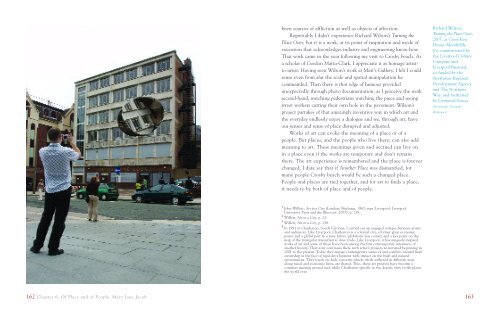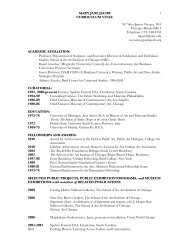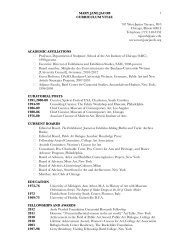Chapter 6. Of Place and of People. Mary Jane Jacob.
Chapter 6. Of Place and of People. Mary Jane Jacob.
Chapter 6. Of Place and of People. Mary Jane Jacob.
You also want an ePaper? Increase the reach of your titles
YUMPU automatically turns print PDFs into web optimized ePapers that Google loves.
een sources <strong>of</strong> affliction as well as objects <strong>of</strong> affection.<br />
Regrettably I didn’t experience Richard Wilson’s Turning the<br />
<strong>Place</strong> Over, but it is a work, at its point <strong>of</strong> inspiration <strong>and</strong> mode <strong>of</strong><br />
execution that acknowledges industry <strong>and</strong> engineering know-how.<br />
That work came in the year following my visit to Crosby beach. As<br />
a scholar <strong>of</strong> Gordon Matta-Clark, I appreciate it as homage artistto-artist.<br />
Having seen Wilson’s work at Matt’s Gallery, I felt I could<br />
sense even from afar the scale <strong>and</strong> spatial manipulation he<br />
comm<strong>and</strong>ed. Then there is that edge <strong>of</strong> humour provided<br />
unexpectedly through photo documentation, as I perceive the work<br />
second-h<strong>and</strong>, watching pedestrians watching the piece <strong>and</strong> seeing<br />
street workers cutting their own hole in the pavement. Wilson’s<br />
project partakes <strong>of</strong> that amazingly inventive way in which art <strong>and</strong><br />
the everyday endlessly enjoy a dialogue <strong>and</strong> we, through art, have<br />
our senses <strong>and</strong> sense <strong>of</strong> place disrupted <strong>and</strong> adjusted.<br />
Works <strong>of</strong> art can evoke the meaning <strong>of</strong> a place or <strong>of</strong> a<br />
people. But places, <strong>and</strong> the people who live there, can also add<br />
meaning to art. These meanings given <strong>and</strong> accrued can live on<br />
in a place even if the works are temporary <strong>and</strong> don’t remain<br />
there. The art experience is remembered <strong>and</strong> the place is forever<br />
changed. I dare say that if Another <strong>Place</strong> was dismantled, for<br />
many people Crosby beach would be such a changed place.<br />
<strong>People</strong> <strong>and</strong> places are tied together, <strong>and</strong> for art to finds a place,<br />
it needs to be both <strong>of</strong> place <strong>and</strong> <strong>of</strong> people.<br />
Richard Wilson,<br />
Turning the <strong>Place</strong> Over,<br />
2007, at Cross Keys<br />
House, Moorfields.<br />
Co-commissioned by<br />
the Liverpool Culture<br />
Company <strong>and</strong><br />
Liverpool Biennial,<br />
co-funded by the<br />
Northwest Regional<br />
Development Agency<br />
<strong>and</strong> The Northern<br />
Way, <strong>and</strong> facilitated<br />
by Liverpool Vision.<br />
(Photograph, Alex<strong>and</strong>ra<br />
Wolkowicz)<br />
1 John Willett, Art in a City (London: Methuen, 1967; repr. Liverpool: Liverpool<br />
University Press <strong>and</strong> the Bluecoat, 2007), p. 238.<br />
2 Willett, Art in a City, p. 23.<br />
3 Willett, Art in a City, p. 138.<br />
4 In 1991 in Charleston, South Carolina, I carried out an engaged critique between artists<br />
<strong>and</strong> audiences. Like Liverpool, Charleston is a colonial city, a former great economic<br />
power <strong>and</strong> a global port in a time before ‘globalism’ was coined, <strong>and</strong> a key point on the<br />
map <strong>of</strong> the triangular transatlantic slave trade. Like Liverpool, it has uniquely inspired<br />
works <strong>of</strong> art <strong>and</strong> some <strong>of</strong> these have been among the first contemporary utterances <strong>of</strong><br />
another history. That story continues there with artist’s projects re-initiated beginning in<br />
2001 to the present. Today they engage contemporary issues <strong>of</strong> <strong>and</strong> conflicts around l<strong>and</strong><br />
ownership in the face <strong>of</strong> rapid development with impact on the built <strong>and</strong> natural<br />
environment. They touch on daily concerns which, while inflected in different ways<br />
along racial <strong>and</strong> economic lines, are shared. Thus, these art projects have become a<br />
common meeting ground <strong>and</strong>, while Charleston-specific in the details, they evoke places<br />
the world over.<br />
162 <strong>Chapter</strong> <strong>6.</strong> <strong>Of</strong> <strong>Place</strong> <strong>and</strong> <strong>of</strong> <strong>People</strong>. <strong>Mary</strong> <strong>Jane</strong> <strong>Jacob</strong><br />
163





